
Visitors interact with a robot guide dog at the Care & Rehabilitation Expo China 2024 in Beijing on Nov 29, 2024. [Photo for China Daily]
During a recent expo, Chinese participants showed their commitment to developing and popularizing high-tech assistive devices to improve the quality of life for the elderly and the disabled so they can benefit from technological advancement and live with dignity and happiness.
The three-day Care & Rehabilitation Expo China 2024 concluded on Saturday in Beijing, during which some state-of-the-art auxiliary facilities and devices using AI and big data technologies were presented. The expo was first launched by the China Disabled Persons' Federation in 2007.
While exploring the event in her wheelchair, Qin Meng, 35, took a look at some high-tech assistive devices such as e-crutches, barrier-free vehicles and rehabilitation devices. She has been unable to walk since she was involved in a car crash in December 2016.
"The assistive devices got much better in recent years. My wheelchair now has self-sealing tires in case of any punctures," she said, adding that she is very interested in high-tech assistive devices that can help her stand and walk, as well as vehicles that are more accessible for wheelchair users.
According to the disabled persons' federation, this year's expo attracted over 300 exhibitors from home and abroad focused on developing devices and facilities to address problems the elderly and disabled have involving accommodations, traveling, healthcare and entertainment.
Some top-notch devices developed by domestic universities, companies and research institutes were also put on display at the expo.
Chen Zhijun, a researcher from Shanghai Jiao Tong University, was operating a six-legged robot guide dog that can lead visually impaired people to their destinations after receiving vocal instructions.
"We have now produced 10 of these robot guide dogs, and they have been undergoing test runs in Shanghai since May this year. The cost for one of these dogs ranges from about 120,000 yuan ($16,500) to 150,000 yuan, but the cost will be reduced to 100,000 yuan each after putting them into mass production," he said.
"The nation now has about 17 million people with visual impairment, but there are only 400 guide dogs available, and it usually costs about 200,000 yuan to train a guide dog. I think the future application of the robot guide dogs will help enhance visually impaired people's quality of life."
Mao Jierong, deputy general manager at Shanghai-based Boin Hearing Technology Co, which makes hearing aids, said that the company has taken five years to develop its own chips and algorithms to make the devices more suitable for Chinese people, who pronounce words differently than people from Western countries.
"Previously, the hearing aids were very expensive and not that affordable for most of the elderly or people with disabilities. We now control the prices within a range of 4,000 to 8,000 yuan and offer a better wearable experience," Mao said.
"People have a stronger willingness to join social events and gain spiritual fulfillment when they have clear hearing."
The nation has done a great deal of work to help disabled people, especially those with financial problems, gain access to assistive devices and services in recent years.
Hu Xiangyang, vice-chairman of the China Disabled Persons' Federation, said at a recent meeting that the federation has organized some programs in recent years to visit disabled people and learn about their need for assistive devices and rehabilitation services.
"We will continue to channel resources to the development of assistive technology in the future, in terms of barrier-free environment construction, talent cultivation and product supplies so that such technology can benefit the disabled in smart and effective ways," he said.